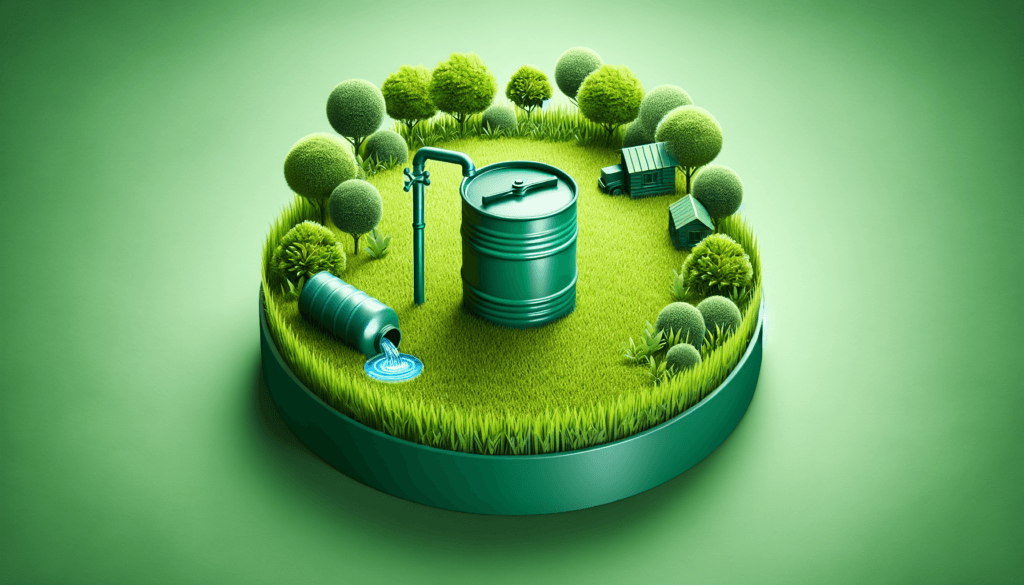Taking care of your lawn doesn’t have to come at the expense of the environment. With the increasing concern for sustainability, it’s important to adopt eco-friendly practices for lawn care. By making small changes in your lawn care routine, such as using natural fertilizers, cutting the grass to the appropriate height, and conserving water, you can maintain a beautiful lawn while minimizing your ecological impact. In this article, we will explore some simple yet effective ways to embrace eco-friendly practices for lawn care. So, let’s get started and make a positive change for both your lawn and the planet!

Water Conservation
Using rainwater
One eco-friendly practice for lawn care is utilizing rainwater. Instead of relying solely on municipal water sources, consider collecting rainwater to use for watering your lawn. You can set up a rain barrel or other rainwater harvesting system to capture and store rainwater. This not only helps reduce your reliance on treated water but also helps prevent stormwater runoff, which can carry pollutants and contribute to water pollution.
Watering during optimal times
To conserve water, it’s important to water your lawn during optimal times. Watering early in the morning or late in the evening helps minimize evaporation and ensures that the water reaches the roots of the grass. Avoid watering during the hottest part of the day, as most of the water will evaporate before reaching the soil.
Regularly checking for leaks
Another water-saving tip is to regularly check for leaks in your irrigation system. Even small leaks can result in significant water waste over time. Inspect your irrigation equipment, including sprinklers, hoses, and connectors, for any signs of leakage. By promptly fixing leaks, you can conserve water and prevent potential damage to your lawn.
Adjusting sprinkler heads
Properly adjusting sprinkler heads is crucial for efficient water usage. Make sure that your sprinkler heads are directing water onto the grass and not onto paved areas or sidewalks. Adjust the spray pattern and distance of the sprinkler heads to ensure uniform coverage without overspray. This will prevent water waste and help keep your lawn healthy.
Choosing drought-tolerant grass
When renovating or establishing a new lawn, consider choosing drought-tolerant grass varieties. These types of grasses are well-suited for regions with limited water availability and can withstand periods of drought without excessive irrigation. Drought-tolerant grasses require less water and maintenance, making them an eco-friendly choice for your lawn.
Chemical-Free Weed Control
Hand pulling
One eco-friendly method of weed control is hand pulling. This involves manually removing weeds from your lawn by pulling them out from the root. While it may require some effort, hand pulling ensures that weeds are completely removed without the use of chemicals. It’s important to pull weeds early before they have a chance to spread and establish themselves.
Mulching
Mulching is not only beneficial for retaining soil moisture but can also help control weeds. Apply a layer of organic mulch, such as wood chips or straw, around plants and in garden beds. This serves as a barrier that blocks sunlight, preventing weed growth. Organic mulch also breaks down over time, enriching the soil with nutrients.
Mowing high
Mowing your lawn at a higher height can help control weeds naturally. When you cut the grass too short, it creates an environment where weeds are more likely to thrive. By leaving the grass longer, it shades the soil, making it difficult for weed seeds to germinate. Additionally, taller grass has deeper roots, which helps it compete with weeds for nutrients and water.
Using natural weed control products
If hand pulling or other manual methods are not feasible, consider using natural weed control products. There are herbicides available that are derived from natural ingredients, such as vinegar or essential oils. These products are generally less harmful to the environment compared to synthetic herbicides and can be an effective alternative for weed management.
Regularly aerating and overseeding
Regularly aerating and overseeding your lawn can also help control weeds. Aeration involves creating small holes in the soil to improve air, water, and nutrient circulation. This helps promote a healthier lawn, making it less susceptible to weed infestation. Overseeding, on the other hand, contributes to a denser grass cover, which naturally suppresses weed growth.

Organic Fertilizers
Composting
Composting is a great way to produce organic fertilizer for your lawn. Kitchen scraps, yard waste, and other organic materials can be composted to create nutrient-rich compost. Use this compost as a natural fertilizer by spreading it evenly over your lawn. Composting not only helps reduce waste but also improves soil health and promotes the growth of healthy grass.
Using compost tea
An alternative to direct compost application is using compost tea. Compost tea is created by steeping compost in water and then applying the liquid to your lawn. It provides essential nutrients to the grass while also introducing beneficial microorganisms to the soil. Compost tea can be sprayed onto the lawn or applied with a watering can.
Applying natural fertilizers
Opt for natural fertilizers that are derived from organic sources, such as bone meal or seaweed extract. These products provide essential nutrients to the soil and promote healthy grass growth. Natural fertilizers are generally slower-release and less likely to cause nutrient runoff, reducing the risk of water pollution.
Avoiding synthetic chemicals
One of the key principles of organic lawn care is avoiding the use of synthetic chemicals. Synthetic fertilizers and pesticides can have negative effects on soil health, water quality, and biodiversity. By opting for organic alternatives, you not only protect the environment but also create a safer and healthier space for your family and pets.
Determining proper application rates
To ensure effective and efficient fertilizer use, it’s important to determine the proper application rates for your lawn. Over-fertilizing can lead to nutrient runoff and water pollution, while under-fertilizing may result in weak and unhealthy grass. Consider conducting a soil test to determine the nutrient requirements of your lawn and adjust your fertilizer application accordingly.
Proper Mowing Techniques
Mowing at a higher height
Mowing your lawn at a higher height is a simple yet effective eco-friendly practice. Set your mower blades to cut the grass at a height of about 3 inches. Longer grass blades provide shade to the soil, reducing weed growth and promoting healthier grass. Additionally, taller grass is more tolerant of drought and less susceptible to disease and damage.
Keeping mower blades sharp
Maintaining sharp mower blades is essential for proper lawn care. Dull blades tear the grass instead of cleanly cutting it, resulting in a ragged appearance and potential damage to the grass. Sharpen your mower blades regularly to ensure a clean cut, which helps the grass recover quickly and reduces the risk of disease and stress.
Using a mulching mower
Investing in a mulching mower can provide additional benefits for your lawn. Mulching mowers are designed to finely chop grass clippings and distribute them evenly back onto the lawn. These clippings act as a natural fertilizer, returning nutrients to the soil and reducing the need for additional fertilization. Mulching mowers also help conserve water by reducing evaporation.
Alternating mowing patterns
Varying your mowing patterns can help promote a healthier and more visually appealing lawn. Mowing in the same direction every time can cause the grass blades to lean in one direction, resulting in an uneven appearance. By alternating your mowing pattern, you encourage the grass to grow upright and create a more uniform and attractive lawn.
Leaving grass clippings on the lawn
Contrary to popular belief, leaving grass clippings on the lawn is actually beneficial for your lawn. Grass clippings are high in nitrogen and act as a natural fertilizer, providing nutrients to the soil. This practice, known as grasscycling, also reduces the amount of yard waste sent to landfills, contributing to a more sustainable lawn care routine.

Soil Health
Testing soil quality
Testing the quality of your soil is essential for maintaining a healthy lawn. Soil tests can determine the nutrient content, pH level, and overall health of your soil. By understanding the specific needs of your soil, you can make informed decisions when it comes to fertilization, irrigation, and other lawn care practices.
Amending soil with organic matter
Improving soil health is vital for sustainable lawn care. One way to achieve this is by amending your soil with organic matter. Adding compost, leaf litter, or other organic materials to your soil helps improve its structure, moisture retention, and nutrient-holding capacity. This creates a healthier environment for grass roots and enhances overall lawn health.
Improving soil drainage
Proper soil drainage is crucial for preventing waterlogging and promoting healthy root growth. If your lawn suffers from poor drainage, consider taking steps to improve it. This may include aerating the soil, adding organic matter to enhance its structure, or creating drainage channels or berms to redirect excess water.
Avoiding compacting the soil
Soil compaction can negatively impact your lawn’s health by restricting root growth and limiting the movement of water and nutrients. Avoid heavy traffic on your lawn, especially when the soil is wet, to prevent soil compaction. If compaction has already occurred, consider aerating the soil to alleviate compaction and promote better root development.
Following proper watering practices
Watering your lawn properly is crucial for maintaining soil health. Overwatering can lead to water waste and increased nutrient runoff, while underwatering can result in stressed and weakened grass. Aim for deep, infrequent waterings to encourage deep root growth and avoid shallow, frequent watering that promotes shallow root development.
Natural Pest Control
Encouraging beneficial insects
Promoting a diverse ecosystem in your lawn can help naturally control pests. Encourage beneficial insects, such as ladybugs and lacewings, by planting flowers and herbs that attract them. These insects feed on pests like aphids and caterpillars, helping to keep their populations in check without the need for chemical pesticides.
Using companion planting
Companion planting involves planting certain plants together to repel pests or attract beneficial insects. For example, planting marigolds near your tomato plants can help deter pests like nematodes. Research companion planting combinations that are suitable for your climate and incorporate them into your garden to naturally control pests.
Creating bird-friendly habitat
Birds are natural predators of many garden pests, including insects and small rodents. Create a bird-friendly habitat in your lawn by providing bird feeders, birdhouses, and birdbaths. Planting trees and shrubs that produce berries or seeds can also attract birds and encourage them to frequent your lawn, reducing pest populations naturally.
Organic pest control techniques
When faced with pest problems, consider organic pest control techniques. This can include using insecticidal soaps or neem oil, which are derived from natural sources and are less toxic to the environment. Mechanical controls, such as handpicking pests or using traps, can also be effective in managing pest populations.
Regularly monitoring for pests
Prevention is key when it comes to pest control. Regularly monitor your lawn for signs of pests, such as chewed leaves or wilting plants. Early detection allows for prompt intervention before the infestation becomes severe. By keeping a close eye on your lawn, you can address pest issues in a timely manner and minimize the need for harsh chemical treatments.

Reducing Lawn Size
Creating functional spaces
Consider reducing the size of your lawn by integrating functional spaces into your landscape design. Create outdoor living areas, such as patios or decks, where you can relax and entertain. By incorporating these spaces into your lawn, you can decrease the overall size of your turfgrass while still enjoying a well-designed outdoor area.
Installing native plant areas
Replace areas of your lawn with native plantings to reduce lawn size and support local ecosystems. Native plants are well-adapted to the local climate and require less water, fertilizer, and maintenance compared to traditional lawns. These plantings provide habitat and food for local wildlife and help enhance biodiversity.
Utilizing hardscaping and mulch
Another way to reduce lawn size is by incorporating hardscaping and mulch areas into your landscape. Use materials such as gravel, pavers, or decking to create paths, seating areas, or play spaces. Mulch areas can serve as low-maintenance ground covers, suppressing weed growth and reducing the need for water and maintenance.
Transitioning to low-maintenance landscaping
Consider transitioning to a low-maintenance landscape design that requires less upkeep than a traditional lawn. This can involve using ground covers, shrubs, or ornamental grasses that are drought-tolerant and require minimal mowing, fertilizing, and watering. Low-maintenance landscaping not only saves time and effort but also reduces environmental impact.
Designing efficient outdoor living areas
When planning outdoor living areas, incorporate elements that promote energy efficiency. Strategically position seating areas and patios to maximize shade during the hottest parts of the day. This reduces the need for artificial cooling and minimizes the heat island effect. Additionally, consider using energy-efficient outdoor lighting to minimize energy consumption.
Energy-Efficient Equipment
Choosing electric or battery-powered lawn care tools
Opt for electric or battery-powered lawn care tools instead of gas-powered alternatives. Electric tools are more energy-efficient and produce zero greenhouse gas emissions. Battery-operated tools offer the convenience of cordless operation while still being more environmentally friendly than their gas-powered counterparts.
Maintaining equipment regularly
Proper maintenance of your lawn care equipment is essential to ensure optimal performance and energy efficiency. Regularly clean and inspect your tools, lubricate moving parts, and replace worn-out or damaged components. Well-maintained equipment operates more efficiently, reducing energy consumption and extending its lifespan.
Properly storing equipment
When not in use, properly store your lawn care equipment to protect it from the elements and prevent damage. Store tools in a clean, dry area to prevent rust and corrosion. Proper storage contributes to equipment longevity, reducing the need for premature replacements and the associated environmental impact.
Investing in energy-efficient irrigation systems
If you have an irrigation system in place, consider upgrading to an energy-efficient model. Smart irrigation systems that use weather data and soil moisture sensors can optimize water usage and prevent overwatering. These systems can be programmed to adjust watering schedules based on actual weather conditions, conserving water and reducing energy consumption.
Using solar-powered outdoor lights
Illuminate your lawn with solar-powered outdoor lights instead of traditional electrical lighting. Solar-powered lights are energy-efficient and rely on solar panels to charge during the day and provide illumination at night. Not only do they reduce energy consumption, but they also add a decorative touch to your landscape.

Beneficial Lawn Practices
Overseeding to promote a thicker lawn
Overseeding is the process of seeding your lawn with grass seed to promote thicker, healthier grass growth. By overseeding, you fill in bare patches and support the growth of new grass. A thicker lawn helps prevent weed infestation, increases the ability to withstand stress, and promotes a lush and attractive lawn.
Not overwatering or overfertilizing
Overwatering and overfertilizing can have negative impacts on your lawn and the environment. Avoid excessive irrigation and only water when necessary to prevent water waste and potential nutrient runoff. Similarly, follow recommended fertilization guidelines and avoid applying excessive amounts of fertilizer, which can contribute to water pollution and harm the ecosystem.
Preventing soil compaction
Soil compaction can hinder root growth and nutrient absorption in your lawn. Prevent soil compaction by avoiding heavy traffic on the grass, especially when the soil is wet. Use designated paths or stepping stones to minimize foot traffic on the lawn and protect the soil structure.
Leaving grass clippings on the lawn
Rather than bagging and disposing of grass clippings, leave them on the lawn. Grass clippings act as a natural fertilizer as they decompose, providing nutrients back into the soil. This practice, known as grasscycling, reduces waste, conserves resources, and promotes a healthier lawn.
Using natural dethatching methods
If your lawn requires dethatching to remove excess dead grass and promote healthy growth, consider using natural methods. Raking with a thatch rake or using a dethatching machine can be effective, but it’s important to avoid overdoing it. Excessive dethatching can harm the root system and disrupt the balance of your lawn.
Soil Health
Testing soil quality
Testing the quality of your soil is essential for maintaining a healthy lawn. Soil tests can determine the nutrient content, pH level, and overall health of your soil. By understanding the specific needs of your soil, you can make informed decisions when it comes to fertilization, irrigation, and other lawn care practices.
Amending soil with organic matter
Improving soil health is vital for sustainable lawn care. One way to achieve this is by amending your soil with organic matter. Adding compost, leaf litter, or other organic materials to your soil helps improve its structure, moisture retention, and nutrient-holding capacity. This creates a healthier environment for grass roots and enhances overall lawn health.
Improving soil drainage
Proper soil drainage is crucial for preventing waterlogging and promoting healthy root growth. If your lawn suffers from poor drainage, consider taking steps to improve it. This may include aerating the soil, adding organic matter to enhance its structure, or creating drainage channels or berms to redirect excess water.
Avoiding compacting the soil
Soil compaction can negatively impact your lawn’s health by restricting root growth and limiting the movement of water and nutrients. Avoid heavy traffic on your lawn, especially when the soil is wet, to prevent soil compaction. If compaction has already occurred, consider aerating the soil to alleviate compaction and promote better root development.
Following proper watering practices
Watering your lawn properly is crucial for maintaining soil health. Overwatering can lead to water waste and increased nutrient runoff, while underwatering can result in stressed and weakened grass. Aim for deep, infrequent waterings to encourage deep root growth and avoid shallow, frequent watering that promotes shallow root development.
Natural Pest Control
Encouraging beneficial insects
Promoting a diverse ecosystem in your lawn can help naturally control pests. Encourage beneficial insects, such as ladybugs and lacewings, by planting flowers and herbs that attract them. These insects feed on pests like aphids and caterpillars, helping to keep their populations in check without the need for chemical pesticides.
Using companion planting
Companion planting involves planting certain plants together to repel pests or attract beneficial insects. For example, planting marigolds near your tomato plants can help deter pests like nematodes. Research companion planting combinations that are suitable for your climate and incorporate them into your garden to naturally control pests.
Creating bird-friendly habitat
Birds are natural predators of many garden pests, including insects and small rodents. Create a bird-friendly habitat in your lawn by providing bird feeders, birdhouses, and birdbaths. Planting trees and shrubs that produce berries or seeds can also attract birds and encourage them to frequent your lawn, reducing pest populations naturally.
Organic pest control techniques
When faced with pest problems, consider organic pest control techniques. This can include using insecticidal soaps or neem oil, which are derived from natural sources and are less toxic to the environment. Mechanical controls, such as handpicking pests or using traps, can also be effective in managing pest populations.
Regularly monitoring for pests
Prevention is key when it comes to pest control. Regularly monitor your lawn for signs of pests, such as chewed leaves or wilting plants. Early detection allows for prompt intervention before the infestation becomes severe. By keeping a close eye on your lawn, you can address pest issues in a timely manner and minimize the need for harsh chemical treatments.
Educational Resources
Attending workshops and classes
Stay informed about eco-friendly lawn care practices by attending workshops and classes in your community. Local garden centers, agricultural extension offices, and environmental organizations often host educational events on various topics related to sustainable gardening and lawn care. These workshops provide valuable insights and practical tips for implementing eco-friendly practices in your own lawn.
Researching local lawn care guidelines
Research and familiarize yourself with local lawn care guidelines specific to your region. Different climates and environments have varying requirements and regulations for lawn care practices. By understanding these guidelines, you can ensure that your lawn care efforts align with local regulations and best practices.
Consulting with agricultural extension offices
Agricultural extension offices are valuable resources for information and assistance with sustainable lawn care. They provide free or low-cost services, such as soil testing, pest identification, and gardening advice. Extension offices have experts who can provide personalized recommendations based on your specific lawn care needs and environmental conditions.
Joining online gardening forums
Engage with like-minded individuals and experts in online gardening forums. These forums offer a platform for sharing experiences, asking questions, and receiving advice from knowledgeable individuals. Participating in these communities allows you to learn from others, gain new perspectives, and stay up-to-date on the latest eco-friendly lawn care practices.
Reading reputable books and articles
There is a wealth of information available in books and articles written by reputable authors and experts in the field of eco-friendly lawn care. Look for books and articles that focus on sustainable gardening practices, organic lawn care, and environmental conservation. By reading these resources, you can expand your knowledge and make more informed choices for your lawn.
Incorporating eco-friendly practices into your lawn care routine not only benefits the environment but also contributes to the health and beauty of your lawn. By using rainwater, employing chemical-free weed control methods, utilizing organic fertilizers, practicing proper mowing techniques, improving soil health, implementing natural pest control measures, reducing lawn size, using energy-efficient equipment, adopting beneficial lawn practices, and seeking educational resources, you can create a lawn that is both sustainable and visually appealing. Embrace these eco-friendly practices, and enjoy a vibrant, thriving lawn that reflects your commitment to a greener future.


